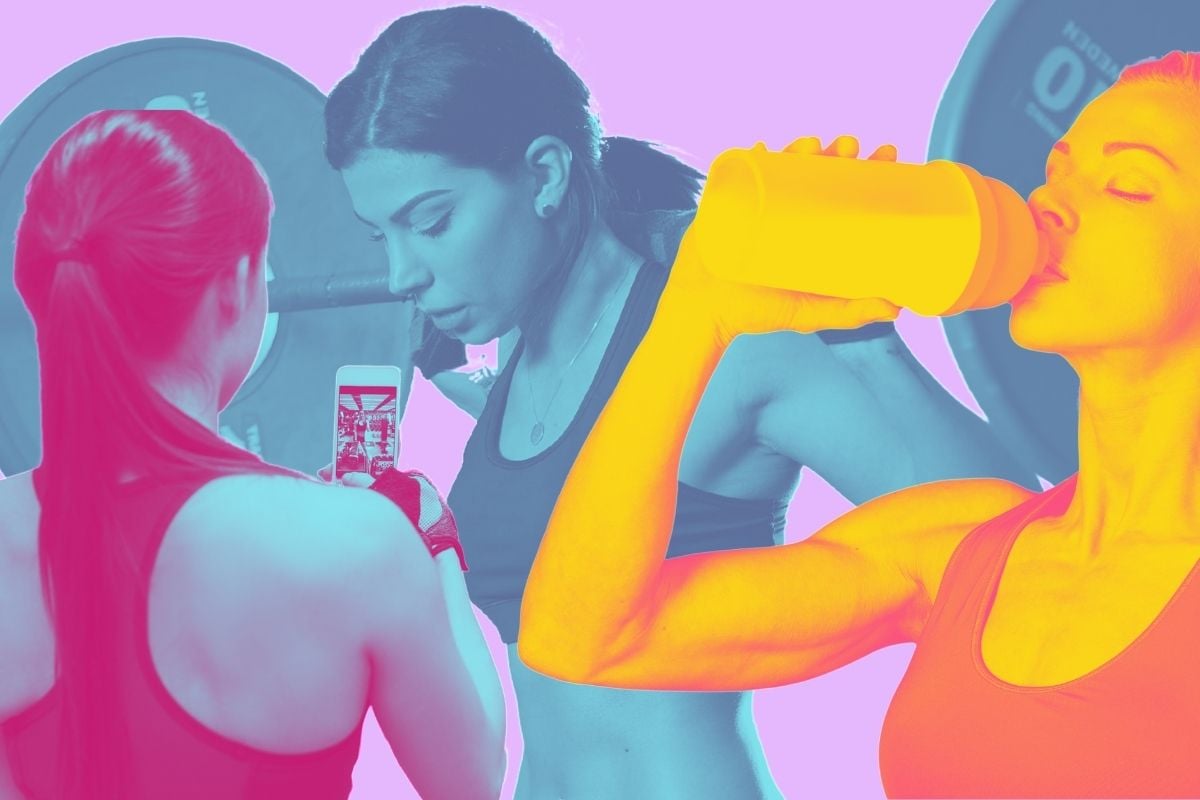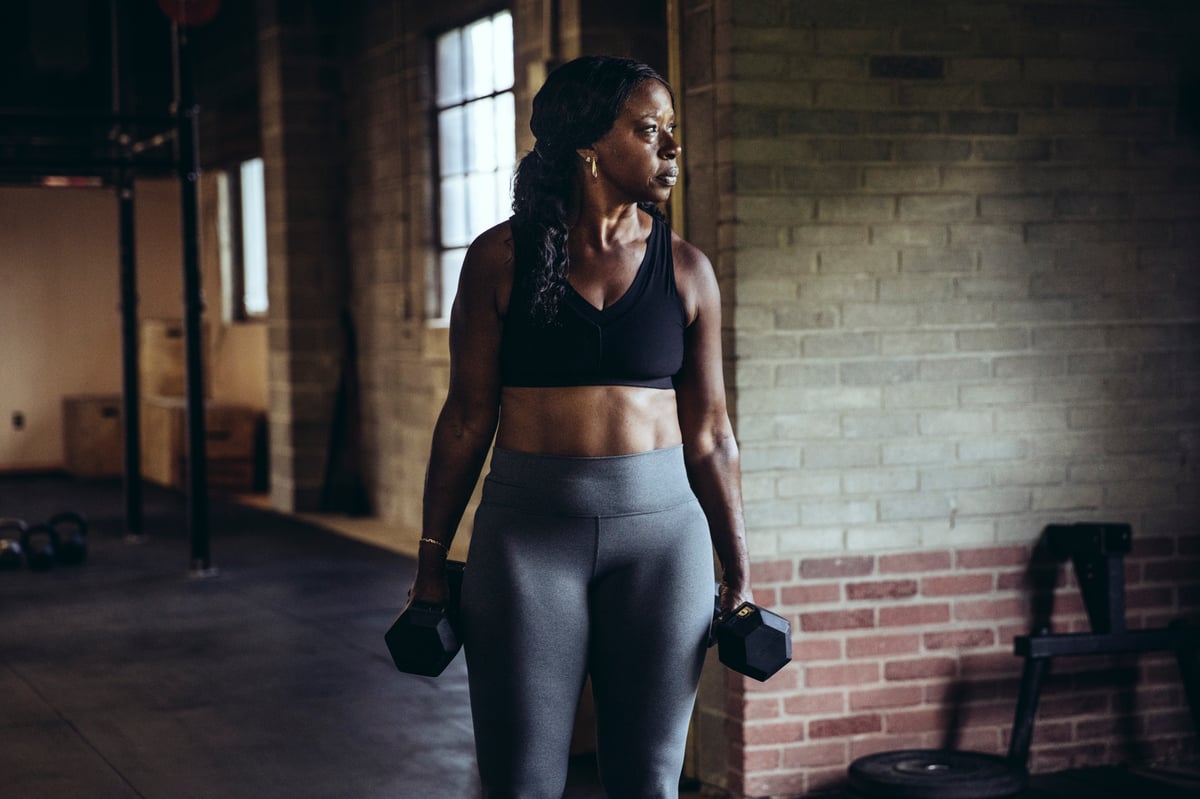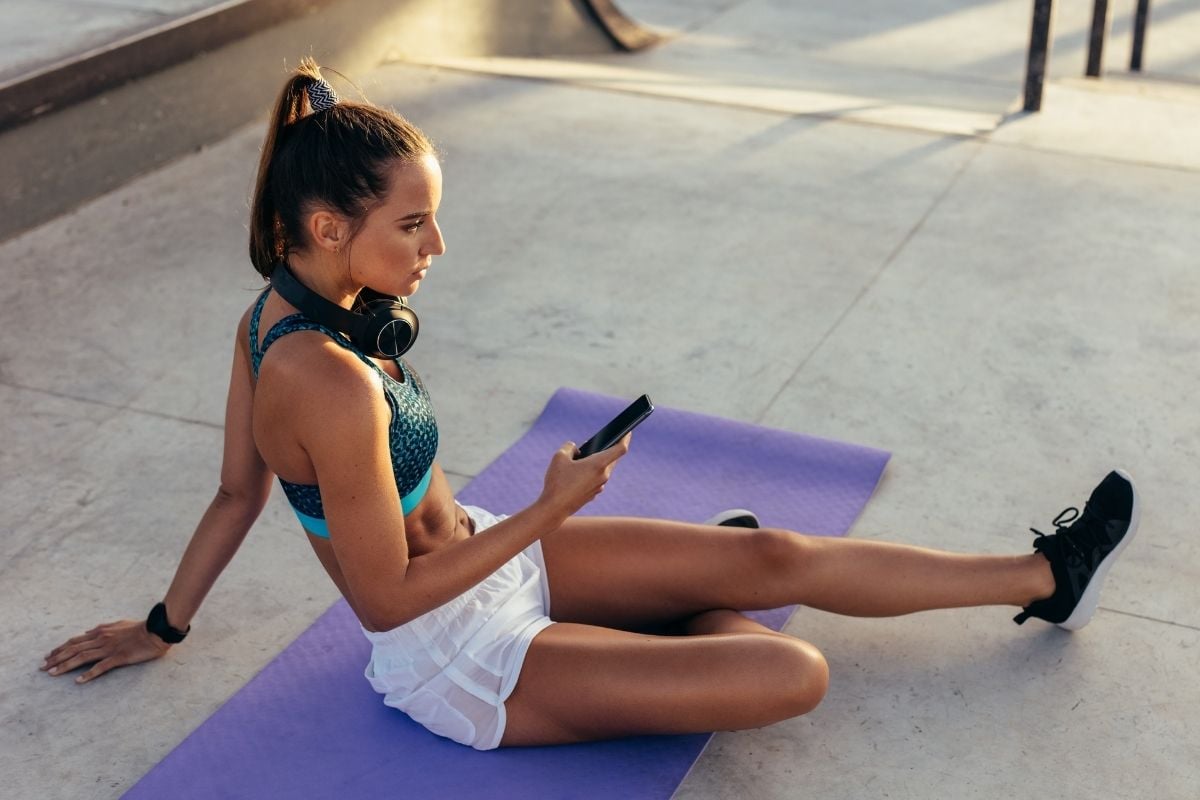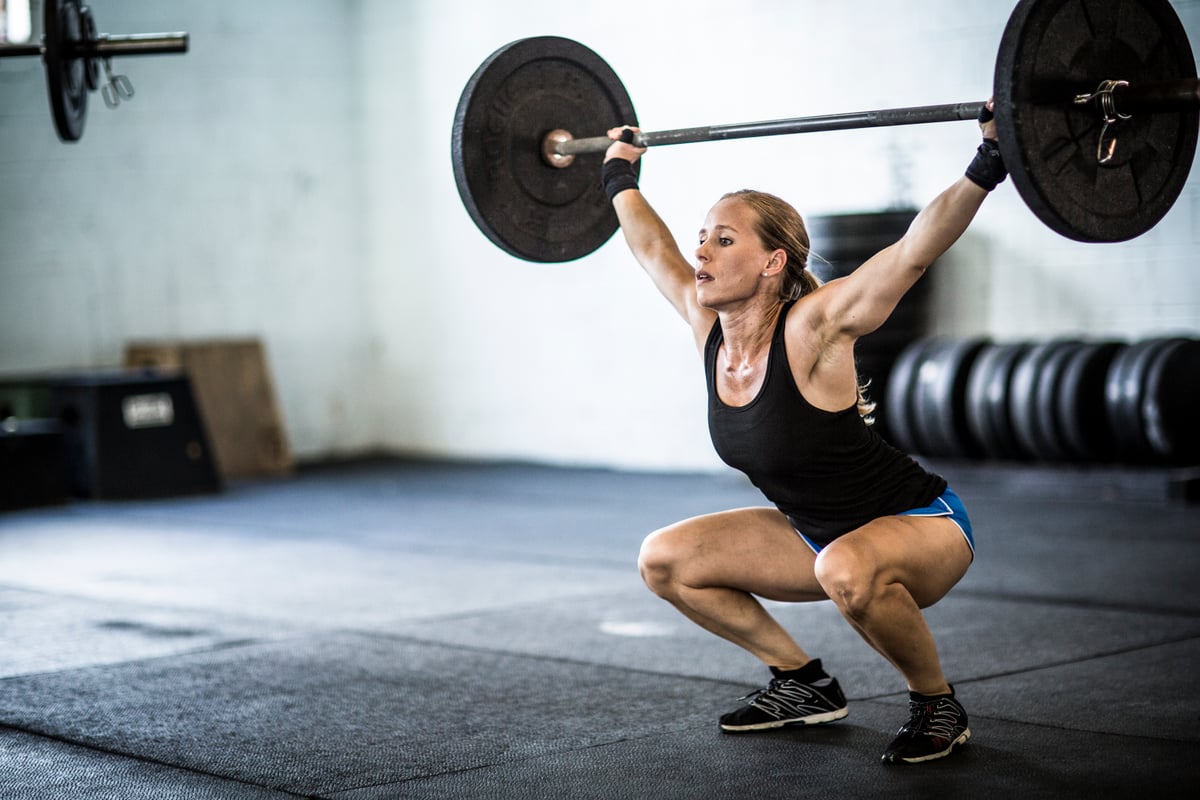
This post discusses eating disorders and could be triggering for some readers.
It's 2021, and hashtags such as #fitspo, #girlswholift, #shesquats, and slogans like "strong is the new skinny" are littered across social media. It's everywhere you look. Women sharing themselves lifting heavy weights, showing off their gains, and touting certain workouts has become the new norm.
And for a while, it seemed like a very positive movement for women and how we view the 'ideal' body image. Powerful! Different! F**k the system!
Because as you know, for quite some time we were repeatedly told that being 'healthy' meant being skinny - and this had a hugely detrimental effect on the eating habits and self-esteem of women.
Watch: Georgia Love on fad diets. Post continues below.
However, while 'diet culture' might've become increasingly irrelevant, is the new body ideal really that different?
Off the back of the 'strong is the new skinny' movement, research is showing that women now feel the increasing pressure to meet this new standard of beauty - stretching the gap to meet the 'ideal' female body image even further.
Fuelled by unrealistic body images on social media, studies are saying it has implications related to body image, self-esteem and compulsive exercise.
Here we look at the standard for female beauty and ask a psychologist, a dietician and a personal trainer if the female body ideal is becoming increasingly harder to attain.
'Fitspiration': The new feminine ideal.
The standard of beauty for women has always been unrealistic. It's nothing new.
And while it's easy to look at media, beauty and fashion, and think we've come so far (which we have, in a way), recent research shows that diet culture and the pressure on improving your body image is just as prevalent as ever.
Looking back at the body image ideals of the mid-2000s - being impossibly thin was the celebrity criteria for success. There was blatantly irresponsible marketing. Fad diets. Fat-shaming slapped on the front page of magazines.
Yet, this kind of culture really hasn't gone anywhere. It's just shifted shape.
Notice how celebrities talking about their 'diet secrets' has now been replaced by celebrities talking about their fitness regimen?
From action movie stars such as Alicia Vikander and Brie Larson to singers such as Jennifer Lopez, celebrity women transforming their figures into muscular powerhouses is the new norm in Hollywood.
In recent years social media use has blown up. And one particular trend that has come out of it is the focus on “fitspiration".
Instagram currently has more than 74 million posts with the hashtags #fitspo and #fitspiration - that is, images and videos of people performing workouts, touting fitness regimens or posing in positions that draw attention to certain muscle groups.
Dietitian, nutritionist and best-selling author Lyndi Cohen, said the new 'fitness' body ideal has been boiling under the surface of social media for years.
"Over the last decade, the ‘skinny’ female body ideal has been replaced by lean, sculpted and yet simultaneously curvy body ideal," said Cohen.
"If the gym selfies sprawled across our social media feeds are anything to go by, it’s now implied that to have a ‘healthy’ body, you must be visibly toned, have a low body fat percentage while somehow still managing to have boobs and a bum."
"In a way, this new ‘fitness’ body ideal may be even harder to attain (and maintain) than the thin body ideal of the past. Now, not only are we meant to track every gram of food we eat, we must also spend many hours of our free time sculpting our body."
According to The Fitness Industry and the New Normal report, strength training is one of the most popular forms of fitness in Australia.
Sean McInroy is a personal trainer and the founder of Apex Strength Society.
He said the growing focus towards strength training is something of a positive step forward for female body image.
"It’s in my experience that the popularisation of strength training has actually helped to shift the general female focus away from chasing an “ideal body type”, which formally would see one’s diet and exercise regime focused solely on losing weight in order to look a certain way. Now it's more towards training and eating for performance improvements," he said.
"Strength training is at its core a pursuit of improving physical capabilities, which is in heavy contrast to the neurotic pursuit of being smaller, being skinnier and weighing less."
However, according to McInroy, training for performance rather than training to look a certain way are at two different ends of the spectrum.
"Strength training will make a woman stronger, more confident, more physically capable and by default create a physique they’re more proud to call their own when they look in the mirror," he said.
"Whereas training to simply look a certain way is driven by negative emotions and a deep association with not being good enough."
So, just how prevalent are these negative emotions?
Is 'strong' a healthy goal to chase?
While the promotion of muscularity on social media may highlight the benefits of healthy exercise, studies have shown that posts are often layered with guilt-inducing messages regarding weight and the body.
In fact, recent research shows 72 per cent of these posts emphasise appearance, rather than health (22 per cent).
"If anything, seeing selfies of ultra-fit influencers and reading about their intense training regimes can make us feel like health is more out of reach," said Cohen.
"We know from research that being exposed to #fitspiration images isn’t helping us become healthier. In fact, it turns out that it’s damaging for our wellbeing. Studies show that seeing #fitspo images don’t motivate us to exercise more while simultaneously damaging our body image."
"This isn’t always the case, as I imagine for some people, seeing #fitspo can motivate them to adopt enjoyable exercise and make healthier food swaps," adds Cohen.
It's important to note that it's not just muscularity that's highlighted as the ideal - recent research shows a thin, toned body type is the gap women are trying to meet.
 Image: Getty
Image: Getty
In a study by Missouri State University, 150 candidates were gathered to see if the women were aware of more female models featuring thin but muscular physiques and whether they wanted the same look, too.
In the first study, 78 female undergraduates evaluated images of U.S. beauty pageant winners over the past 15 years on dimensions of thinness, muscularity, and attractiveness. The results indicated that muscularity and thinness ratings of pageant winners significantly increased over time.
In study two, 64 female undergraduates evaluated two different versions of the same image of a model: a thin muscular image and a thin only image, in which the appearance of muscularity was removed through digital editing.
When images were presented in pairs, results indicated that participants found the thin muscular image more attractive than the thin only image.
Co-author of the study, psychologist Frances Bozsik wrote in an article, "There’s a deceitful aspect of rhetoric surrounding “fitspiration” – with benign implications that it’s simply all about being healthy – we fear that our culture may be in the midst of a more toxic promotion of an ideal female body that only leads to more dissatisfaction."
Is 'strong is the new skinny' just diet culture rebranded?
But why or how has the feminine ideal shifted over the years? What is the drive behind women now pursuing a more muscular, stronger physique?
According to McInroy, the shift away from the “ideal female body” of the past and towards a fuller and more muscular female body is a reflection of the general increase in inclusivity within society.
"The ever-growing acceptance of women of all shapes and sizes to be empowered to be who they are and who they want to be, has translated into how women choose to exercise and allowed women to more comfortably explore other means of working out, rather than simply endlessly running on a treadmill," he said.
"The growth of Crossfit as a training option has also played a big role in not just generally popularising lifting heavy weights and getting incredibly strong but has added to society’s inclusivity and shown that women aren’t feeble. Women aren’t weak. They are strong and capable of incredibly impressive things."
However, at the other end of the spectrum, Cohen said that for some women the pressure and negative emotions surrounding the push towards being 'strong' is all the same as the 'skinny' culture of the past.
She said, "The reality is that #fitspo and #fitspiration is the new 'thinspiration' - which is just diet culture rebranded. These days, we’re being sold diets in disguise via ‘healthy lifestyle plans’ that claim to be balanced - when they are anything but."
"Sadly, it’s more socially acceptable to be on a highly restrictive diet and spend hours at the gym than it is to exist in a larger body."
Psychologist Nancy Sokarno from Lysn said that while the focus is now on 'fitness', 'health' and 'wellness' - the media messaging all seems to contain the age-old ideal - thinner, albeit muscular bodies.
"In 2021, it feels as though the diet culture is masked underneath the “wellness” culture. There is certainly a move towards holistic wellbeing, or being “strong” and healthy, however how that plays out in each individual is different (unfortunately it’s not always healthy)," said Sokarno.
She adds, "In the age of the digital era, there does seem to be a lot of pressure on women to maintain a certain physique. However, if we look back through history, women still had pressure, but just from different mediums."
"It used to be coming from the pages of a magazine, whereas these days it seems to be coming through our screens via places like Instagram or Facebook."
 Image: Getty
Image: Getty
By creating this new ideal, experts say we've essentially added an extra dimension onto a standard that's already difficult for most people to obtain.
"It’s a lot of pressure, both physically and mentally, to feel as though you need to continually meet these body standards. We all have different body types and it’s sometimes completely impossible – and unhealthy - to reach that aspiration," said Sokarno.
As Cohen pointed out earlier, not only do women now feel they need to restrict what they're consuming, but now they also need to focus on building muscle and perfecting their exercise routines.
"I’ve noticed in recent years that clients have become even more fearful of carbohydrates including incredibly healthy foods like fruit and starchy vegetables," she said.
"At the same time, there’s an unhealthy obsession with consuming large amounts of protein - regardless of whether it’s highly processed or unenjoyable. Calories counting has been replaced with obsessive macro-counting, with both styles of eating requiring religious monitoring of everything that goes into your mouth."
"The demand for eating disorder support has been surging in Australia in recent times. Helplines across the country have reported an increase in calls, and the number of people being treated for eating disorders during COVID has increased by 25 to 50 percent," said Cohen.
And she's right. The fact is that despite a growing movement towards body positivity, young women (and men) continue to develop body dysmorphia and disordered eating at an alarming rate.
Studies have investigated the impact of 'fitspiration' images on women's body image, finding that exposure to this sort of content led to increased negative mood and body dissatisfaction and decreased self-esteem.
Sokarno said this is reflective of what she is seeing in her consulting rooms.
"Throughout the years there are always different patterns and it really depends on the individual. There’s definitely a pattern within younger people who feel pressure about looking good for social media, but this also affects older people as well," said Sokarno.
"What I have found though is younger people have a different perception of social media – they’ve grown up with it – so they can place a lot more emphasis on it."
It's important to note here, however, that this dissatisfaction with body image isn't always the case for everyone.
As McInroy explains, "There will always be a section of the population who have an unhealthy relationship with themselves, their diet and exercise regime and ultimately how they look in the mirror. BUT the more recent popularisation of being strong allows all women to focus on changing their bodies into stronger versions of themselves."
"Yes, this carries with it a change in their appearance and often eating habits, but ultimately is a development of intrinsic confidence and personal development rather than the continual picking-apart of oneself when chasing unattainable, and unhealthily, thin body goals."
He said that the popularity of being a "strong and lean" woman is, at its foundations, a far more positively driven pursuit than that of the previously championed “ideal female physiques” of the past.
"Developing strength is intrinsically confidence-boosting. The empowerment experienced by overcoming a physical challenge is unquestionable. And when we look at what strength training is, we see it’s a continual turnover of challenge and achievement."
"Developed over time, it creates not just a far stronger and physically capable individual but a deeply confident version of oneself through overcoming so many tangible challenges on a regular basis."
When McInroy first started training in 2002, he said women were not seen on the weights floor.
"If they were in the gym at all they were tucked away on some sort of cardio equipment because they’d bought into the idea that they should be skinny and that lifting weights would make them bulky."
"Firstly, this whole narrative is laughable because gaining muscle is physiologically very difficult and simply put, nobody accidentally becomes a bodybuilder."
 Image: Getty
Image: Getty
These days, he said female clients are no longer "scared" to try strength training and be out on the weights floor with men. And they're generally more interested in being strong rather than focusing on being thin.
"Though they usually start it to try to shape a certain body feature, they stick with it for reasons beyond the superficial," he said.
"The more recent popularisation of strength training for women has been a movement of incredible empowerment. I’ve been a trainer in a large commercial gym and more recently my own private studio, since 2014."
"Throughout this time I’ve helped shift the training focus of hundreds of women, away from the empty pursuit of “never being skinny enough” and towards the fulfillment and empowerment experienced when one’s training becomes focused on achieving performance improvements."
Ultimately, it's important to know that health and fitness is not a one-size-fits-all kind of deal - and you should always seek advice from a professional before making any changes to your diet or lifestyle.
"I think for every person– the body ideal should be you, at your best. As long as you’re living a healthy lifestyle and not putting pressure on yourself, try to learn to be ok about being confident in your own skin," said Sokarno.
"Remind yourself that most of the time what you see on social media or in the pages of a magazine isn’t real life – and if it is, it’s generally just the highlight reel"
"Also remind yourself that oftentimes these body ideals that we’re aspiring to do take a lot of work, and that person usually has a host of people that help them to get there (personal trainers, chefs etc)! Certain standards are just not attainable for regular folk!"
Above all, Cohen said to make yourself aware of who you're following on social media - and know what kind of content brings you down.
"My Pinterest and Instagram feeds used to be filled with images of 'perfect' gym bodies in crop tops and before and after photos that I thought would motivate me to exercise. In reality, all these images did was make me feel like my body was never good enough - no matter how much I exercised or what I weighed," she said.
"I've come to accept that my healthy body will always have cellulite, stomach rolls, hips dips and a flat bum. It’s not worth sacrificing 95 per cent of my life to weigh five per cent less. That’s because I refuse to give up my health to look like the so-called 'picture of health'."
Anyone looking for support with eating disorders or body image issues is encouraged to contact the Butterfly Foundation on 1800 33 4673 or email, support@thebutterflyfoundation.org.au.
What do you think? Is there mounting pressure for women to be strong and skinny? Share your thoughts with us in the comment section below.
Feature image: Canva/Mamamia

